|
1914-1918, THE
GREAT WAR
Through Printmaker's Eyes
The First World War produced more war-related art than any war before or since.
Being the first war to call on volunteer soldiers and then to impose general conscription, meant that many artists were themselves combatants, directly involved in the conflict and experienced, at first hand, life at the front as serving soldiers in the midst of action. And quiet intervals in the war allowed time for sketching.
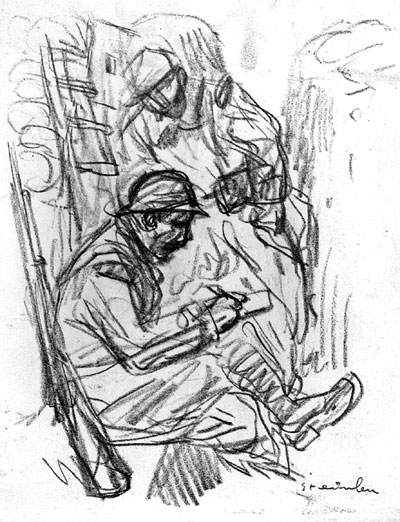 |
Theophile
Steinlen: Soldier sketching.
Original lithograph, 1915.
The right-hand image of Feuille de Croquis,
No.2. |
Making
war and making art may seem anomalous activities
but during the past five hundred years scarcely a
century has passed without European countries engaging
in war and artists taking it up as a theme, though
mainly focussing in the past on the ‘picturesque’ panoply of war and celebrating national victories.
It
is noteworthy, and of particular relevance to this
catalogue, that the two great earlier exceptions,
in which the artists recorded and commented on the
cruelties of war, rather than glory, and its ill
effects on the civilian population, Callot’s Miseries
of War (prompted by the Thirty Years War in the 16th century) and Goya’s Disasters
of War (concerning the early 19th century campaign of Napoleon in Spain) were both expressed in series of original etchings, and aquatints.
Graphic
art at the service of ‘graphic’ content.
Printmaking
had an important place in First World War art, though
it is seldom given the limelight received by First
World War paintings.
The
prints produced were impressive in their quantity,
quality and variety, as witnessed by this catalogue
dedicated specifically to the work of printmakers.
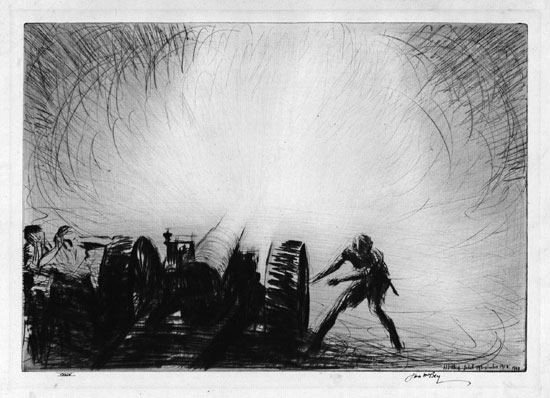
James McBey:
Zero. A sixty-five pounder opening fire, Jelil,
Sep.19, 1918. Drypoint.
McBey served as an officer in France
until the summer of 1917, when he was appointed the
official war artist to Egypt.
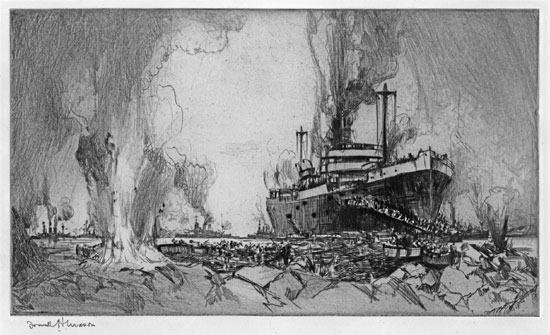
Frank
Henry Mason: The Collier Transport ‘River Clyde’ landing
troops at V. Beach, Sedd-el-Bahr, in the Dardanelles,
25th April, 1915 (Anzac Day). Drypoint.
Mason served
in the Royal Naval Volunteer Reserve in the North Sea
and in the Mediterranean and Suez Canal.
Artists
chose to make prints, rather than paintings, for
a variety of reasons. For some it was because they
were essentially graphic artists, it was their chosen,
usual, means of expression, for others it was prompted
by a commission.
Artists
continued to exhibit throughout the war years and
the exhibitions were well attended. In a period of
censorship there was a ready market during the war
for images the public found informative as well as
works of art.
Prints
being multiples were available and affordable for
numerous people to be able to acquire. Editions were
sometimes sold in their entirety to benefit war-related
charities. An example being Muirhead Bone’s drypoint of Piccadilly Circus in 1915 with the searchlights at night, of which an impression is included in the catalogue. In addition to fundraising for the Red Cross and Belgian refugees, prints were also produced for the government as propaganda for recruiting purposes, and though they were largely ignored in the various Official War Art schemes, the one major commission, from the Department of Information in 1917, The
Great War: Britain’s Efforts & Ideals, involved 18 artists in making a series of 66 lithographs.
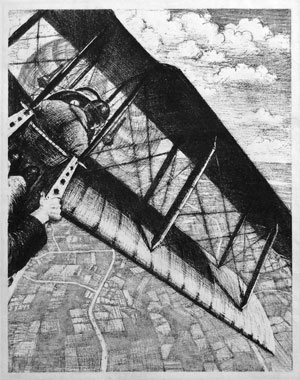 |
|
Christopher
Nevinson: Banking at 4000 Feet.
Lithograph,
1917,
for ‘Building Aircraft’,
one of Britain’s war ‘Efforts’.
Nevinson volunteered in 1914, serving for a
time as a stretcher bearer in Dunkirk with
the Friends’ Ambulance Service. In 1917
he was appointed an official war artist on
the Western Front. |
|
Though
prints by British artists predominate, other nationalities
are represented too, both from the Allies and the
Central Powers. The catalogue includes prints by
American, Canadian, French, German, Austrian, Galician
and Czech artists.
The
catalogue represents almost every one of the defining
aspects of the Great War. Not only was it the first
World war, fought simultaneously on several fronts,
involving many nationalities, it was also the first
mechanised war, dominated by artillery, resulting
as never before in mass carnage, the ruination of
towns and villages and devastation of the landscape.
It
was the first in which civilians were subject to
air raids; the first with aerial combat and submarine
warfare; the first to use the tank, and gas, as weapons;
that saw the introduction of the tin hat and the
invention of dazzle camouflage. Equally it was the
first war in which women played an important role,
not just as nurses but in replacing men in factories
and on the land, so that for practical purposes skirt
lengths shortened and women began to wear trousers;
the first to touch every household.
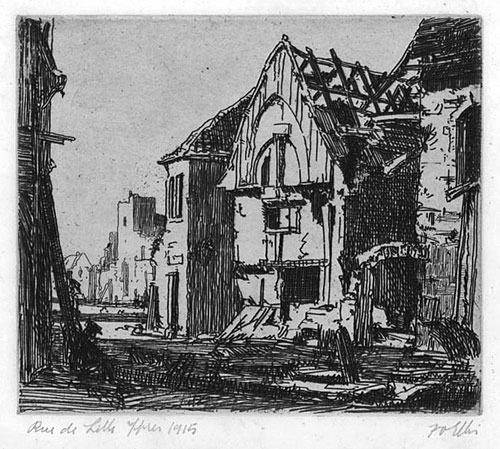
Frederick Ellis:
Rue de Lille, Ypres, 1915. Etching.
Ellis served
as a gunner in the second battle of Ypres and suffered
the effects of gas poisoning

Robert
Henry Smith: Dazzle ships in convoy, escorted
by a destroyer. Etching.
Smith
was in the Royal Naval Volunteer Reserve and served
at the Battle of Jutland.
The
catalogue is arranged to follow the chronology of
the war, charting as it were, its progress.
The
selection of prints offered aims to show the wide
range and rich variety of themes which the war evoked.
The images are equally a testament and
memorial to those who served.
More
images from the catalogue are shown elsewhere on
the website in a recently archived Home
Page Selection.
Published
October 2014
to accompany an exhibition at the Court
Barn Museum, Chipping Campden.
A5 (octavo - 210 x
147 mm); 108 pages, 156 illustrations, 26 in colour
Introductory Essay; Chronology; Bibliography; and
99 items described
(U.K.
price
£15; International orders £20)
Prints
available
Prints from this catalogue are still
available.
^ Return to the top of this page ^
|
|
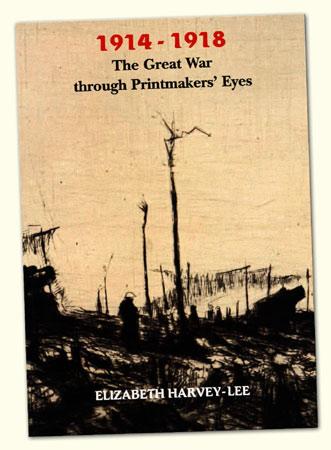
Artists
included in the catalogue:
- Aiken J M
- Austin R S
- Barraud C H
- Beckmann M
- Bellows G W
- Berne-Bellecour J J
- Bone M
- Boutet H
- Brangwyn F
- Brüning M
- Busset M
- Büttner E
- Campbell N M
- Clément-Servau
- Colin P E
- Crawshaw L T
- Dix O
- Eby K
- Ellis F V
- Forain J L
- Griggs F L
- Grieffenhagen M
- Guillaume A
- Hampton H G
- Hassam C
- Hepburn J W
- Hermann-Paul R G
- Hübner U
- Jansen F M
- Jonas L H
- Kollwitz K
- Laske O
- Laurens J P
- Lepère A
- Lismer A
- Ludovic-Rodo (Pissarro)
- Mason F H
- McBey J
- Moss S D
- Nash P
- Nevinson C R W
- Packard S E
- Pryse G S
- Robertson P
- Schmutzer F
- Shepperson C A
- Simpson J
- Smith R H
- Steinlen T A
- Strang I
- Unold M
- Vik K 0
- West J W
- Wolfsfeld E
- Wood W T
- Wyllie W L
Return to the top
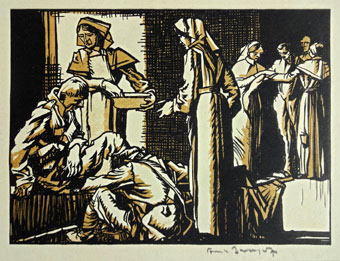
Frank
Brangwyn: Tending the Wounded. Woodcut, 1915,
from
a series of six.
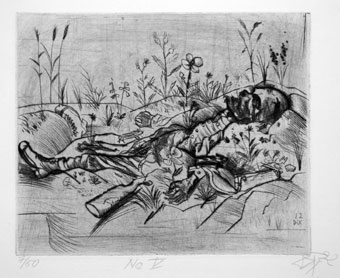
Otto
Dix: Dead Soldier. Drypoint,
from the series Death & Resurrection,
1922.
Dix served as a gunner on the Western Front
and in Belorussia.
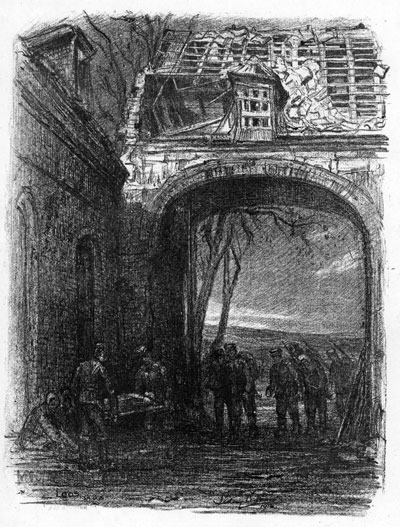
Sidney
Moss: Loos Advanced Dressing Station. Lithograph,
1916.
Moss served in the Labour Corps, the Royal
Army Medical Corps
and the Field Ambulance Territorial
Force in France & Salonika. |